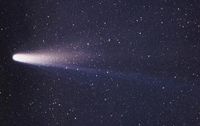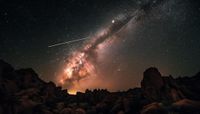The Eta Aquarids meteor shower, one of the most anticipated astronomical events of the year, reached its peak on the night of May 5 to 6, 2025. This spectacular phenomenon, originating from the remnants of Halley's Comet, illuminated the skies across various regions, particularly benefiting those in the southern hemisphere.
Active from April 19 to May 28, the Eta Aquarids provide a dazzling display as Earth traverses the trail of particles left by the famous comet. Although Halley's Comet will not return until 2061, its legacy continues to shine through these meteor showers, which are visible without the aid of telescopes.
Experts estimate that under optimal conditions, observers in the southern hemisphere could see up to 50 meteors per hour. The director of public observation at the Adler Planetarium in Chicago, Michelle Nichols, emphasized the simplicity of watching meteor showers: "You only need your eyes and, if possible, a dark sky." This advice holds true for anyone hoping to catch a glimpse of the celestial show.
On the night of the peak activity, meteorologist Marc Chenard reported that parts of the Midwest, including Minnesota, Iowa, and Missouri, enjoyed clear skies, making it easier for spectators to witness the meteors. However, in northern South America, including Colombia and Venezuela, conditions were less favorable, with cloud cover likely obscuring views of the meteor shower.
For those in Argentina, the Eta Aquarids offered an exceptional viewing opportunity. Shauna Edson from the National Air and Space Museum noted that these meteors are a direct indication of Earth's passage through the trail of Halley's Comet, which has been observed for centuries. "When you see one, you're witnessing pieces of Halley igniting in the sky," she explained.
As the comet travels through the solar system, it leaves behind a trail of debris that collides with Earth's atmosphere, creating the bright streaks of light known as meteors. These particles can enter the atmosphere at speeds exceeding 66 kilometers per second, producing the spectacular light shows that have captivated skywatchers for generations.
For those hoping to catch the Eta Aquarids, the best time to observe was just before dawn on May 6, when the radiant point of the meteor shower, located in the constellation Aquarius, was high in the sky. Observers were encouraged to lie back and scan a broad area of the sky rather than focusing solely on the constellation.
Despite the challenge posed by a waxing moon, which illuminated about two-thirds of its surface, many people managed to see several meteors, especially in rural areas away from city lights. "The best conditions for seeing a meteor shower are a clear sky, without the moon or clouds, between midnight and dawn," Nichols advised.
In Guatemala, the Eta Aquarids also graced the skies, with astronomers noting that the peak of activity occurred in the early hours of May 6. Local expert Edgar Castro highlighted that the visibility was somewhat limited, but there was still potential for sightings on the morning of May 7.
In San Juan, Argentina, astronomy enthusiasts captured two luminous flashes from the meteor shower, celebrating their successful observations despite the challenges of light pollution in the city. "We managed to capture not one, but two shooting stars, amidst 246 attempts," shared the group, showcasing the excitement and passion for astronomy.
Halley's Comet, which completes its orbit around the sun every 76 years, was last seen in 1986 and is set to return in 2061. Its historical significance is profound; Edmond Halley successfully predicted its return in 1705, and since then, it has become a focal point of astronomical study.
As the Earth continues its journey through space, meteor showers like the Eta Aquarids remind us of the dynamic nature of our universe. Each bright flash in the night sky serves as a reminder of the remnants of Halley's Comet, a cosmic artifact that continues to enchant and inspire.
Looking ahead, the next significant meteor shower will be the Southern Delta Aquarids, scheduled for late July, followed by the Orionids in October. Each of these events offers another chance for enthusiasts and casual observers alike to connect with the wonders of the cosmos.
In conclusion, the Eta Aquarids meteor shower not only provides a breathtaking visual experience but also connects us to the legacy of Halley's Comet, a celestial phenomenon that has fascinated humanity for centuries. As we gaze up at the night sky, we are reminded that we are part of a larger universe, filled with mysteries waiting to be explored.


